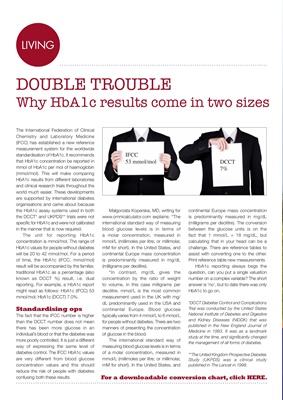
LIVINGLIVING
The International Federation of Clinical
Chemistry and Laboratory Medicine
(IFCC) has established a new reference
measurement system for the worldwide
standardisation of HbA1c. It recommends
that HbA1c concentration be reported in
mmol of HbA1c per mol of haemoglobin
(mmol/mol). This will make comparing
HbA1c results from different laboratories
and clinical research trials throughout the
world much easier. These developments
are supported by international diabetes
organisations and came about because
the HbA1c assay systems used in both
the DCCT* and UKPDS** trials were not
specific for HbA1c and were not calibrated
in the manner that is now required.
The unit for reporting HbA1c
concentration is mmol/mol. The range of
HbA1c values for people without diabetes
will be 20 to 42 mmol/mol. For a period
of time, the HbA1c (IFCC, mmol/mol)
result will be accompanied by the familiar,
traditional HbA1c as a percentage (also
known as DCCT %) result, i.e. dual
reporting. For example, a HbA1c report
might read as follows: HbA1c (IFCC) 53
mmol/mol; HbA1c (DCCT) 7.0%.
Standardising ops
The fact that the IFCC number is higher
than the DCCT number does not mean
there has been more glucose in an
individual's blood or that the diabetes was
more poorly controlled. It is just a different
way of expressing the same level of
diabetes control. The IFCC HbA1c values
are very different from blood glucose
concentration values and this should
reduce the risk of people with diabetes
confusing both these results
Małgorzata Koperska, MD, writing for
www.omnicalculator.com explains: "The
international standard way of measuring
blood glucose levels is in terms of
a molar concentration, measured in
mmol/L (millimoles per litre; or millimolar,
mM for short). In the United States, and
continental Europe mass concentration
is predominantly measured in mg/dL
(milligrams per decilitre).
"In contrast, mg/dL gives the
concentration by the ratio of weight
to volume, in this case milligrams per
decilitre. mmol/L is the most common
measurement used in the UK with mg/
dL predominantly used in the USA and
continental Europe. Blood glucose
typically varies from 4 mmol/L to 6 mmol/L
for people without diabetes. There are two
manners of presenting the concentration
of glucose in the blood.
The international standard way of
measuring blood glucose levels is in terms
of a molar concentration, measured in
mmol/L (millimoles per litre; or millimolar,
mM for short). In the United States, and
DOUBLE TROUBLE
Why HbA1c results come in two sizes
continental Europe mass concentration
is predominantly measured in mg/dL
(milligrams per decilitre). The conversion
between the glucose units is on the
fact that 1 mmol/L = 18 mg/dL, but
calculating that in your head can be a
challenge. There are reference tables to
assist with converting one to the other.
Print reference table new measurements
HbA1c reporting always begs the
question, can you put a single valuation
number on a complex variable? The short
answer is 'no', but to date there was only
HbA1c to go on.
*DCCT Diabetes Control and Complications
Trial was conducted by the United States
National Institute of Diabetes and Digestive
and Kidney Diseases (NIDDK) that was
published in the New England Journal of
Medicine in 1993. It was as a landmark
study at the time, and significantly changed
the management of all forms of diabetes.
**The United Kingdom Prospective Diabetes
Study (UKPDS) was a clinical study
published in The Lancet in 1998.
DCCT
7%
IFCC
53 mmol/mol
For a downloadable conversion chart, click HERE.